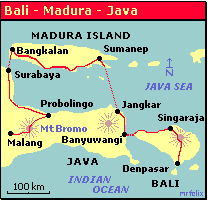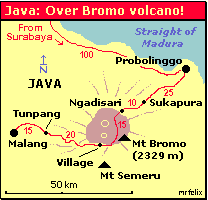|
|
Ride
5
Indonesia: The Volcano Tour! Leg 1: Over Bali and into Java Leg 2: Across unknown Madura Island The
Ride: Surabaya
to Malang via Mt Bromo, a sometimes difficult, 200 km, 3 day jaunt through
extreme and changing conditions. The highlight of this trip
is the ride across the floor of Bromo volcano and the spectacular views
from the tracks and villages along the volcano rim. The Road: The roads are paved and in good condition all the way from Surabaya to Probolinggo and further on to Ngadisari on the edge of Bromo volcano. The traffic is the real problem. On Bromo itself, there is an OK dirt track across the volcano floor, but the road deteriorates badly as it plunges down the western side of the mountain, where it's sealed but heavily potted. Just past Tunpang one picks up the main Malang road which is in good condition. The Hills: Surabaya to Probolinggo is flat, but immediately leaving Probolinggo there's a steep 35 km climb up the north side of Mt. Bromo to the small town of Ngadisari, on the edge of the volcano. The road is sealed but narrow in sections. The track across the volcano is flat but there's a steep 1 km climb out over the rim to the set of little villages on the south end of the crater. From here it's an extremely steep plunge down to the small town of Tunpang. The Ferries: If you're coming from Pulau Madura, there's a ferry running back and forth between Kamal (on Pulau Madura) to Surabaya every 20 minutes. Bikes are welcome. Traffic: In Java the traffic is heavy, dangerous and not for the faint hearted. The ride down from Surabaya to Probolinggo is unpleasant. Once past Probolinggo and climbing up the east side of Bromo to Sukapura, the traffic drops off to a trickle. There is no motorised traffic on the volcano itself, and hardly a car all the way down the mountain till one gets close to Malang. Town to town: Surabaya is a very large, grimy, noisy industrial town that I found to be grossly unpleasant. The contrast to Pulau Madura can't be overstated. There's plenty of hotels and an overnight stay may be enough. The road down to Probolinggo is in good condition but the traffic is appalling. It's 100 km I wouldn't do again. Probolinggo itself is quite a nice mid-sized town, very well laid out and worth a day or two's exploration on the bike. From here the road sweeps up the mountain and it's a steady 25 km climb all the way to the small town of Sukapura. It might be time for an early lunch before the last 10 steep kilometres into Ngadisari, on the edge of the crater. You'll notice the lack of oxygen at this altitude, so take it easy. Ngadisari is a funky little touristy sort of a place, with cheap guest houses and small cafes serving big bowls of soup and steaming mugs of hot chocolate. It can get nippy up here at night and as I said, the lack of oxygen is a factor in any strenuous bike activity. The views across the volcano are magnificent and it pays to make this your base for a few days heavy exploring. It's about 15 km due south across the floor of Mt Bromo volcano itself to the other side. The road is a dirt track but the scene is a strange, almost surreal luna landscape; very eerie. The area is called 'The Sea of Sand' by the locals. It's easy to ride, but would be boggy and sad during the height of the wet season. (See Did the Americans fake the Apollo moon landings? at left.) A steep 1 km track leads out of the volcano to a set of villages perched
on the west side of the crater. The road here is somewhat unbelievable: a thin sealed section with 300
metre (thousand foot) drops on each side. It reminds one of the Himalayas,
with its terraced fields cut into the side of the mountain and small houses
dotting the landscape. The plunge down to Tunpang is one of the steepest runs I've ever done. I wore out a set of brake rubbers and eventually dismounted and walked most of the way down after nearly going over the handle bars on a couple of occasions. The road is sealed, but heavily potted, and runs through deep forests and the odd village or two. The ride down from Ngadisari is a remarkable day's journey through wild and extremely beautiful country. Past Tunpang one picks up the highway into Malang, which is sealed and busy. Welcome back to Java traffic. Malang is surprisingly ambient for a large Javanese town. Once a major Dutch colonial administration centre, the city maintains a slow order and goes about its business in a friendly and relatively polite fashion. Worth a few days.
|
|
Other Cyclists: Didn't see any, but the locals tell me they come through every now and then. Places to stay: You can get decent digs in in all the major towns for as low as 5 or 10 dollars. The Locals: Java has one of the densest populations in the world. Take especial care, particularly around bus and train stations as pickpockets and thieves abound. Food, drink & transport: Small towns dot the highway every 10 or so kilometres, so there's lots of food and drink available. On the west side of the mountain the traffic is extremely thin, so if you get into trouble you may have to walk to the nearest village to arrange a lift out. The locals out here in the country are helpful and friendly. Bike shops : Bike shops in all the major towns. Cheap and reliable.
|
|
|
Java's tough on lots of accounts. Physically it's one of the most beautiful places on earth, which its rich, lush forests and astonishing mountain volcanoes, but a population of 80 million produces enough touts, pickpockets and bad drivers to make life uncomfortable for the Western cyclist.. The Indonesian Monetary Collapse: The Indonesian monetary collapse of 1998 has caused great hardship throughout the country, and things are a little unstable politically and economically. The fall of the Indonesian rupiah has made things very cheap for Western tourists (the rupiah fell 90% in value in 1998), but also a little more dangerous. In parts of Indonesia, including Jakarta, some folks don't have enough to eat. Is it dangerous? Since the monetary collapse, Java's been experiencing a lot of social turmoil and unrest. It's probably not a good time to go until things settle down a bit. Language: Indonesian Bahasa is the official language throughout Indonesia, and it pays to get a little of it under your belt for when you get out into the boonies. It's an easy language to learn, actually a strange Creole, originating as a trading language between Javanese, Chinese, Arabian and European traders some four hundred years ago. However, in the tourist areas especially and throughout most of Indonesia a lot of people speak passable/fluent English. You will also find the odd Dutch speaker, but they tend to be older generation Indonesians who were active during the Dutch colonial period which ended soon after WWII. |


